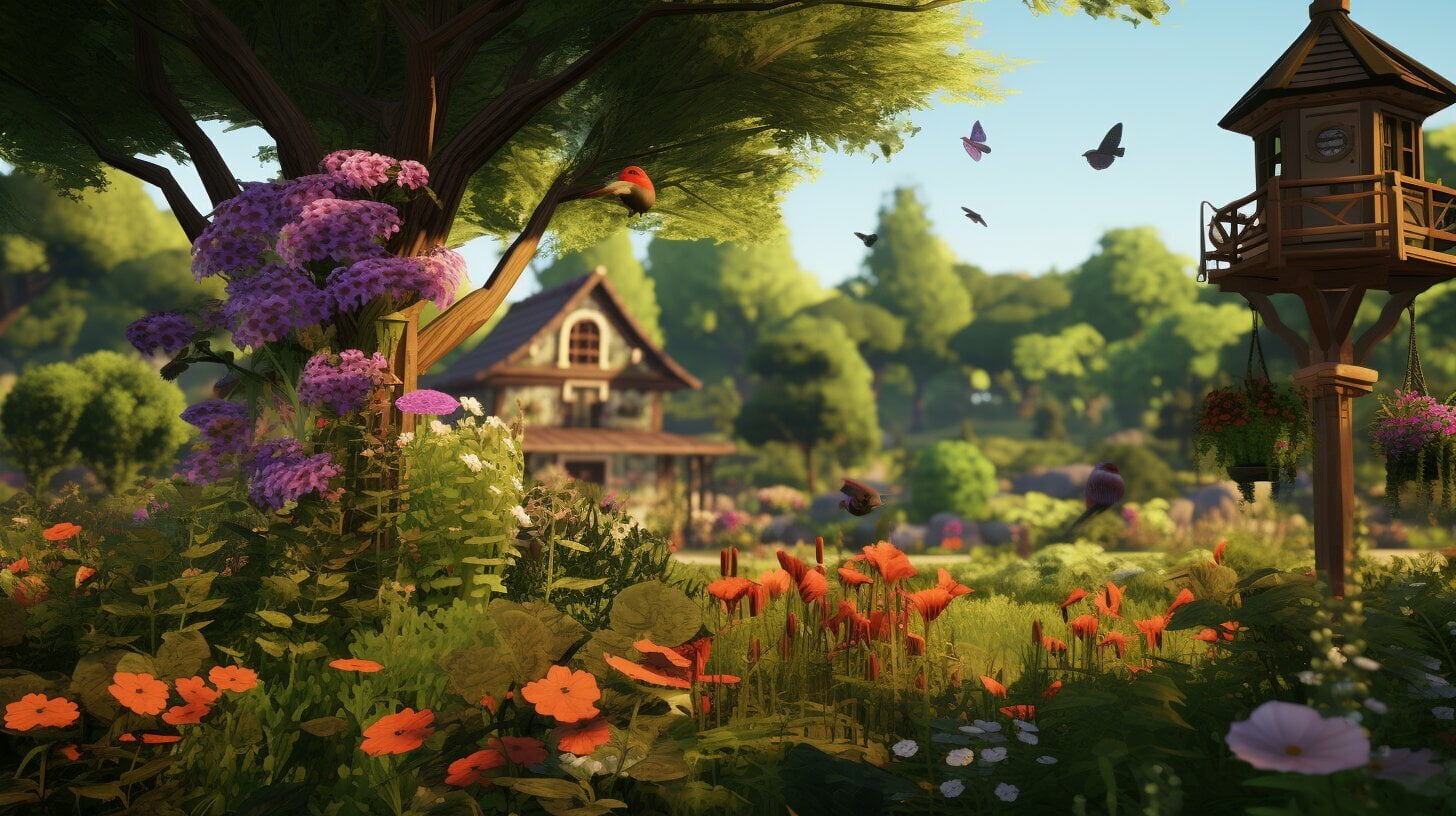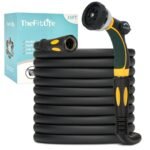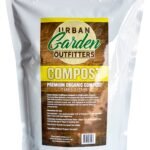Welcome to our guide to wildlife friendly gardening! As nature enthusiasts, we understand the importance of creating a harmonious connection with the wildlife that surrounds us. By transforming our gardens into wildlife space, we can provide a safe haven for a variety of species and contribute to conservation efforts.
Read More OutdoorGoodness Articles:
Wildlife friendly gardening involves creating a space for local fauna to thrive, providing a sanctuary and food sources that support their needs. By incorporating native plants and diverse habitats, we can attract a range of wildlife to our gardens and sustain the local ecosystem.
Key Takeaways:
- Wildlife friendly gardening is essential in preserving local fauna and supporting biodiversity.
- Native plants play a crucial role in attracting and sustaining wildlife in our gardens.
- Creating diverse habitats and providing food and shelter are key components of a wildlife-friendly garden.
Why Make Your Garden And Lawn Wildlife Friendly Gardening? Think Bee, Butterfly and a Pond
As we strive towards a more sustainable and eco-friendly future, it’s important to consider the impact of our garden on the local environment. Creating a wildlife-friendly garden is a simple yet effective way to support local fauna and promote biodiversity. By attracting and providing sanctuary and food for various wildlife species, we can contribute to conservation efforts and cherish the beauty of nature right in our own backyard.
A wildlife-friendly garden is about more than just aesthetics. It’s about creating a thriving ecosystem that benefits both humans and wildlife. By creating a wildlife sanctuary, we can invite a variety of species into our garden and support their survival in urban environments. From bees and butterflies to birds and small mammals, there are endless opportunities to attract and observe wildlife in your garden.
By choosing to create a wildlife-friendly garden, we can make a tangible impact on local ecosystems and help to conserve wildlife for generations to come. With simple wildlife friendly gardening practices, we can provide a safe haven for wildlife and create a thriving garden that is truly harmonious with nature. So why not join us in creating a wildlife-friendly garden today?
Create a Wildlife-Friendly Wildlife Garden For Wildlife
Creating a wildlife-friendly garden involves more than simply planting a few flowers and hoping for the best. With a little planning, you can design a garden that provides food and shelter for a variety of wildlife species.
Incorporating Garden Creative Design Elements
When designing your wildlife space, it is important to consider the different habitats needed by wildlife. Incorporating a variety of garden creative design elements can help attract different species of wildlife. For example:
| Garden Design Element | Benefits for Wildlife |
|---|---|
| Ponds and Water Features | Attracts amphibians, and birds, provides drinking water for wildlife |
| Shrubbery and Hedges | Provides cover and nesting habitats for birds and small mammals |
| Nest Containers and Birdhouses | Provides nesting sites for birds and bats |
Incorporating these design elements into your wildlife sanctuary can attract a wide variety of wildlife to your garden.
Using Native Plants and Wildflowers
Native plants and wild flowers are an important element of any wildlife-friendly garden. They bring food and habitat for a variety of wildlife species. When selecting plants for your garden, choose native species over non-native ones. Native plants are adapted to local growing conditions and have established relationships with local wildlife.
Consider incorporating nectar-rich plants to attract pollinators, such as bees and butterflies. Some examples of nectar-rich plants include:
- Milkweed
- Liatris
- Black-eyed Susan
By using native plants and wild flowers, you can create a beautiful and thriving garden that supports local wildlife.
Easy Ways to Create a Wildlife-Friendly Garden: Wildlife Garden Ideas
One of the key goals of wildlife friendly gardening is to provide habitats that support local wildlife species and create a healthy ecosystem. By planting a variety of plants that provide both food and shelter, you can attract a diverse range of wildlife to your garden.
When creating wildlife hide-outs, it’s important to consider which types of wildlife you want to attract. For example, birds may need nesting sites and food sources, while butterflies may require specific nectar-rich plants to thrive. By providing the right habitat for each species, you can help create a diverse and thriving community of wildlife in your garden.
| Wildlife Species | Plants Provide |
|---|---|
| Butterflies | Nectar-rich flowers, host plants for caterpillars |
| Birds | Nesting sites, berry-bearing plants, insect-rich areas |
| Bees | Pollen-rich flowers, nesting sites |
| Small mammals | Sheltered areas, food supplies |
Remember, native plants are key to attracting and supporting local wildlife. They offer the right type of sanctuary and food supplies for local species, and they thrive in the local climate and soil conditions. By planting native species, you’ll be supporting the local ecosystem and creating a healthy and vibrant garden.
Provide multiple layers of vegetation to create diverse habitats, including trees, shrubs, and ground cover. Consider incorporating birdhouses, bat boxes, and insect hotels to provide nesting sites for wildlife. Create a pond or water feature to attract frogs, toads, and other aquatic creatures.
By taking a thoughtful and deliberate approach to creating wildlife spaces in your garden, you can provide a safe haven for local wildlife and create a thriving ecosystem that benefits both you and the environment.
Nurturing Native Plants, Shrubs and Wildflowers: Make It a Home For Wildlife
One of the best ways to create a wildlife-friendly garden is by nurturing native plants and wild flowers. Not only do they give food and shelter for local wildlife species, but they also add beauty and interest to the garden. Here are some tips on how to incorporate native plants and wild flowers into your wildlife-friendly garden:
Choose the Right Plant Species
When selecting plants for your garden, choose native species that are suitable for your local climate and soil conditions. These plants are adapted to the local ecosystem and will be more resilient and easier to maintain. Look for plants that provide things for wildlife, such as nectar-rich flowers that attract butterflies. You can also choose plants that provide shelter and nesting sites for birds, such as bushes and trees.
Grow Plants in Clumps
Grouping plants together in clusters creates a more natural look and makes it easier for wildlife to find food and shelter. It also creates a more attractive and dramatic effect in the garden, especially when different plant species are grouped together. For example, you can create a wildflower meadow by planting different types of wild flowers in a designated area.
Provide Nectar-rich Flowers
Butterflies are attracted to nectar-rich flowers, so make sure to plant a variety of flowers that bloom throughout the season. This will provide a continuous source of food for these beautiful insects, encouraging them to visit your garden regularly. Examples of nectar-rich flowers include lavender, coneflowers, and bee balm.
Maintain Your Plants
Make sure to provide your plants with the right amount of sunlight, water, and nutrients they require to thrive. Regular pruning and maintenance will help keep your plants healthy and attractive. Deadheading spent flowers will also encourage new growth and prolong the blooming season, providing more food for wildlife.
Nurturing native plants and wild flowers in your wildlife-friendly garden is an easy and effective way to attract wildlife and promote biodiversity. By delivering food, shelter, and habitat for local wildlife species, you are creating a beautiful and harmonious connection with nature that benefits both humans and wildlife.
Mindful Maintenance Practices: No Pesticides or Pests
As we work to create a garden that attracts and supports wildlife, it’s important to adopt mindful maintenance practices. Not only do these practices help protect the wildlife in our gardens, they also promote a healthy and vibrant ecosystem that benefits us all.
One area that requires attention is our lawns. While they may look neat and tidy, lawns can actually be harmful to many wildlife species. Constant yard trimming can destroy vital habitats and disrupt the natural cycles of insects and other small creatures. Consider reducing the size of your lawn and incorporating wildflower meadows instead. This will not only provide a more wildlife-friendly environment, but will also add a beautiful and colorful element to your garden.
When mowing your lawn, try to keep it at a height that allows the grass to grow and provide cover for small animals. Avoid mowing too frequently and leave some areas uncut to encourage the growth of wild flowers and other beneficial plants.
When dealing with pests or diseases in your garden, opt for natural pest control methods instead of pesticides. Chemical pesticides can be harmful to both wildlife and humans, and can disrupt the delicate balance of your garden ecosystem. Use companion planting, crop rotation, and other organic methods to control pests and keep your garden healthy.
Lastly, embrace the use of wild flowers and native plant varieties to create a garden that is truly wildlife-friendly. These plants provide important habitat, food, and shelter for a wide range of wildlife species, and add beauty and interest to your garden.
By adopting these mindful maintenance practices in our gardens, we can create a beautiful and thriving space that supports the local wildlife and promotes a healthy and balanced ecosystem for us all to enjoy.
Inviting Native Wildlife into Your Garden Design: Help Wildlife Grow Plants
Transforming your garden into a wildlife-friendly oasis not only benefits the local fauna but also brings us closer to nature. Here are some simple and practical ideas that can help us invite wildlife into our garden:
Get to Know Your Local Wildlife Trusts
Trusts work tirelessly to protect and preserve local wildlife and natural habitats. By joining your local trust, you can participate in community-led conservation efforts, gain access to useful resources, and connect with fellow nature-lovers.
Add Nest Boxes and Feeders
Providing nest containers for birds and small mammals can help them find suitable shelter to thrive. Similarly, adding garden bird feeders filled with seeds and nuts can attract a range of feathered friends to your garden throughout the year.
Create a Frog-Friendly Habitat
Creating a garden pond filled with aquatic plants, such as water lilies, is an excellent way to support the local frog population. Toads and newts may also benefit from a shallow pond with plenty of surrounding foliage. Include slug and snails in surrounding soil.
Explore Wildlife Sanctuary Ideas
Get inspired by exploring the countless wildlife space ideas available online or in wildlife friendly gardening magazines. From bee-friendly wildflower meadows to butterfly gardens filled with nectar-rich plants, there’s no shortage of creative ways to attract and support local wildlife.
By incorporating some of these ideas into our wildlife-friendly garden, we can create a haven for native species while fostering a deep connection with the natural world.
Embracing Wildlife-Friendly Practices
Creating a wildlife-friendly garden is just one step towards supporting local wildlife populations. To make a real impact, we must embrace wildlife-friendly practices beyond our own gardens and engage with the broader community.
Organizations such as the National Wildlife Federation and Wildlife Trusts are doing important work to promote and support wildlife conservation efforts. By getting involved in their initiatives, we can learn more about local wildlife and contribute to their conservation. It’s easy to find ways to get involved – from participating in community wildlife surveys to supporting campaigns for habitat preservation.
There are also many simple steps we can take to promote wildlife beyond our gardens. For example, we can install nest containers in our local parks or put up bird feeders in our neighborhoods. We can also reduce our use of pesticides and herbicides, which can harm wildlife, and choose environmentally-friendly alternatives instead.
By embracing wildlife-friendly practices in all aspects of our lives, we can help create a healthier and more vibrant ecosystem for local wildlife to thrive in. Let’s take the first step by transforming our gardens into havens for wildlife and continue to champion for the wild creatures that make our world a more beautiful and magical place.
Conclusion
As we come to the end of our guide, we hope you’re feeling inspired to create your own wildlife-friendly garden. By embracing these practices, we have the power to make a real difference in preserving our local fauna and promoting biodiversity.
Remember, every garden has the potential to become a wildlife space. By incorporating native plants and wild flowers, providing diverse habitats, and using organic wildlife friendly gardening methods, we can attract a myriad of wildlife species to our gardens.
Creating a wildlife-friendly garden not only benefits our local wildlife but also enhances our own experience of nature. Watching birds and butterflies flit around our gardens, listening to the sounds of frogs and bees, and witnessing the interconnectedness of our ecosystem reminds us of the beauty and importance of the natural world.
So let’s embrace our role as stewards of the earth and transform our gardens into havens for wildlife. Let’s join together to create a world where wildlife and humans can thrive in harmony. Together, we can make a difference.
FAQ
Q: What is wildlife friendly gardening?
A: Wildlife friendly gardening is a practice that involves creating a garden that provides habitat and food for wildlife species while promoting biodiversity and conservation efforts.
Q: Why should I choose wildlife friendly gardening?
A: By choosing wildlife friendly gardening, you can support local wildlife populations and contribute to the preservation of ecosystems. It also provides an opportunity to create a beautiful and vibrant garden that attracts a variety of wildlife species.
Q: How do I design a wildlife garden?
A: Designing a wildlife space involves incorporating diverse habitats, such as ponds, shrubs, and nest boxes, to attract different wildlife species. It is also important to include native plants and wild flowers to create an appealing environment for both humans and wildlife.
Q: How can I create wildlife habitats in my garden?
A: To create a wildlife sanctuary, you can deliver food, water, and shelter for different wildlife species. This can include bird feeders, nesting sites, and suitable plants that provide habitat and food supplies.
Q: Why is nurturing native plants and wildflowers important?
A: Nurturing native plants and wild flowers in your wildlife-friendly garden supports local ecosystems, attracts butterflies, and provides vital food items for caterpillars. It also adds beauty and diversity to your garden.
Q: What are mindful maintenance practices in a wildlife-friendly garden?
A: Mindful maintenance practices involve using organic wildlife friendly gardening methods and natural pest control measures to avoid harming wildlife. It also includes responsible mowing practices and incorporating wild flowers and meadow areas to support a healthy ecosystem.
Q: How can I invite wildlife into my garden?
A: You can invite wildlife into your garden by providing nesting sites, bird feeders, and water sources. Creating specific habitats, such as garden ponds for frogs and toads, can also attract a variety of wildlife.
Q: How can I embrace wildlife-friendly practices beyond my garden?
A: Embrace wildlife-friendly practices by engaging with organizations such as the National Wildlife Federation and Wildlife Protectors. Participating in community-driven initiatives and supporting local wildlife conservation efforts are also great ways to make a positive impact.

Meet Kevin Goodell, your outdoor adventure coach! With a passion for nature ignited in childhood, Kevin brings a wealth of experience and expertise to simplify tough outdoor skills. As a U.S. Army veteran and former Sergeant, he has honed his leadership and teamwork abilities while developing a deep love for the great outdoors.
Kevin’s dedication to outdoor activities spans biking, birdwatching, national park trips, and archery/golf. With his friendly and approachable demeanor, he is committed to guiding individuals of all ages and skill levels towards unforgettable outdoor experiences.
Harnessing his extensive knowledge and personal achievements, Kevin is your go-to resource for learning and enjoying various outdoor pursuits. Whether you seek thrilling adventures or serene nature escapes, Kevin’s professional yet friendly approach will ensure an engaging and informative experience. Embark on your next outdoor adventure with Kevin Goodell and embrace the beauty of nature like never before.






